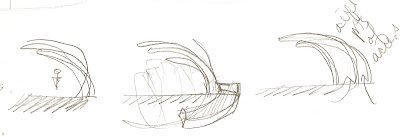Following the past couple days, I seem to have strayed from my previous paths of examining Mangrove ecosystems. This was partially due to my indecisiveness of what I actually wanted to achieve and the fact that, although I found Mangrove roots to be extremely interesting, there was no systematic approach to the way they grew and were rather arbitrary. That being said, Mangroves didn't seem to be very conducive to the performance of steel and I decided to explore other plant species.
One plant that I previously did have interest in but didn't really research in-depth was the Venus Fly Trap.


I initially didn't look much into this carnivorous plant because, the well-known concept of catching something and trapping prey seemed like such a very simple and redundant idea.
However; what did interest me the most about the Venus-Fly trap was the fact that the trapping mechanism is actually specialized in a certain way to avoid non-prey stimuli or prey that can easily escape from being too small and may not be beneficial towards the plant to digest. Two of the trigger hairs surrounding the lobe must be touched in succession within 20 seconds of each other or one hair must be touched twice in rapid succession,
whereupon the lobes of the trap will snap shut in about 0.1 seconds. In the open, untripped state, the lobes of the plant are convex, but in the closed state, the lobes are concave due to the rapid flipping motion when closing the trap.
This then inspired an idea for a canopy that would act as a shading device during sunny days and could possibly collect rainwater. My initial idea was that this canopy could also have a water fountain, and when a certain amount of rainwater would be collected, the canopy would enclose and filter the water allowing it to be used for drinking water below and what not. This didn't seem to be a very successful idea as it would only be useful for when it rained (about only 10-15 days a month) and a certain volume also couldn't be controlled.
So the idea progressed into a structure that would still be a shading device during sunny days and transform into shelter/protection from the rain through a flipping mechanism in panels that would (when closed) be a protected canopy. The idea of sensitivity from the rain still has to be further developed but...
Here are some sketches ...still in the works


I feel more confident that I am finally moving in some sort of direction
..as I should be because, it's ...eeks... almost the 3rd week of 2nd semester! (technically the 4th)
I have yet to watch the TED video Vince just posted on plant behaviour, but I have a feeling that I will no doubt gain some interesting insight from it.
More to come... time to sleep ..it is now 2:45am...(did anyone else notice the time posting for this blog is completely wrong?)











































